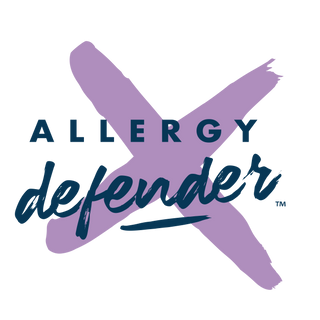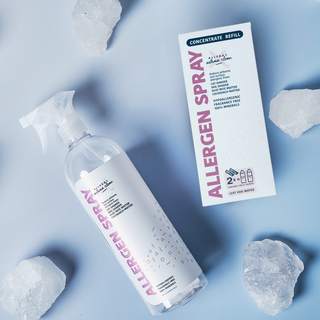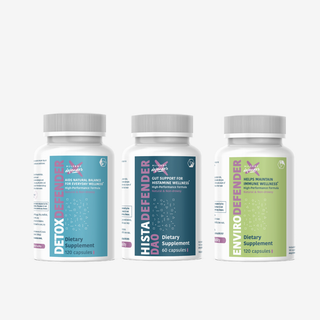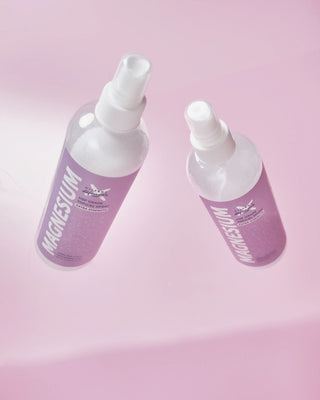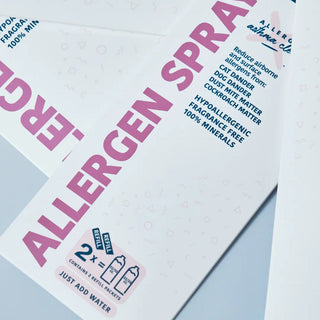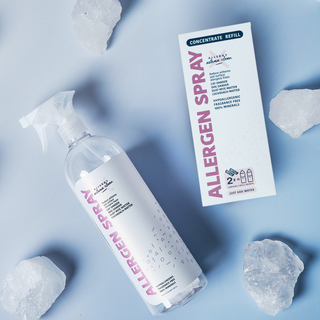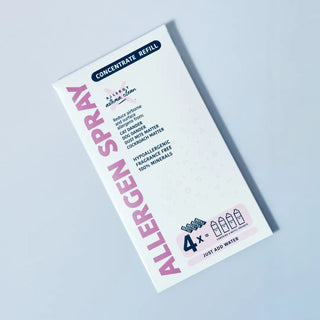

Clearing the Air
Can f 1
Understanding the Protein Behind Dog Allergies
TL;DR: Can f 1 is the major allergen protein produced in dogs' saliva and skin that causes allergic reactions in millions of people worldwide. Despite claims of "hypoallergenic" breeds, every dog produces Can f 1—making true allergen-free dogs a myth. These microscopic proteins become airborne and settle on surfaces throughout your home, triggering symptoms even in homes without dogs. Understanding Can f 1 is essential for managing dog allergies effectively, and innovative solutions are finally addressing both airborne and surface allergens simultaneously.
Key Takeaways
- Can f 1 is the primary dog allergen, affecting 10-20% of the global population with symptoms ranging from rhinitis to severe asthma.
- Every dog breed produces Can f 1—there is no truly hypoallergenic dog. So-called hypoallergenic breeds actually produce higher Can f 1 levels in their hair and coat than regular breeds.
- Can f 1 exists in two states simultaneously: airborne particles you breathe and surface allergens embedded in fabrics, furniture, and flooring throughout your home.
- Dog allergens are universally present in US homes, even in households that don't own dogs, due to passive transfer from clothing and visitors.
- Traditional allergen products fail because they only address one problem: surface-only sprays miss airborne allergens, while air purifiers can't treat the allergens embedded in your home.
- Allergy Asthma Clean Allergen Spray by Allergy Defender is the only product that neutralizes Can f 1 both in the air and on surfaces. Up to 99% of the 4 majors allergens on surfaces and up to 95% of 4 majors allergens. Providing complete protection instead of partial solutions.
- Labrador retrievers produce less Can f 1 than golden retrievers, though both breeds still produce enough to trigger allergic reactions in sensitive individuals.
Understanding Can f 1 empowers you to make informed decisions about living with dogs while managing your allergies effectively.

What Is Can f 1?
Can f 1 (Canis familiaris allergen 1) is a lipocalin protein that serves as the primary allergen responsible for dog allergies in humans. This protein is predominantly produced in dogs' salivary glands and secreted through their saliva, though it's also found in their dander, urine, and skin secretions. When dogs lick their fur during grooming—and dogs groom themselves far more than most people realize—they spread Can f 1 from their saliva across their entire coat.Unlike cat allergens, which are remarkably uniform across all feline breeds, Can f 1 shows significant variation between individual dogs and breeds. Studies have shown that Labrador retrievers produce lower levels of Can f 1 in their saliva compared to golden retrievers, though both breeds produce enough to cause reactions in allergic individuals.Here's what makes Can f 1 so problematic: once it's on your dog's fur, it dries into microscopic particles that become airborne with any movement. These particles can remain suspended in the air for extended periods and adhere to virtually every surface in your home—furniture, carpets, walls, bedding, and clothing.
The Science: How Can f 1 Works at a Molecular Level
At the molecular level, Can f 1 is a lipocalin protein—a family of proteins that bind and transport small hydrophobic molecules. The natural Can f 1 protein has a molecular weight of approximately 20 kilodaltons and maintains its allergenic properties through a stable structure.
What's particularly interesting about Can f 1 is that, unlike the major cat allergen Fel d 1, it shares structural similarities with lipocalins from other animals. This means that some people sensitized to Can f 1 may also experience cross-reactivity with allergens from other species, though Can f 1 itself is the primary culprit in dog allergies.
Recent research published in 2024 continues to explore the genetic variability of Can f 1 across breeds, offering hope that selective breeding might eventually reduce allergenic potential in service dogs and other working breeds.
Why Is Can f 1 So Hard to Remove From Your Home?
If you've ever tried to eliminate dog allergens from your living space, you've discovered how frustratingly persistent they are. Can f 1's properties make it particularly stubborn:
It's sticky and clingy. The protein's structure allows it to bind tightly to fabrics, carpets, upholstery, and even hard surfaces. It doesn't just sit on top of materials—it penetrates and embeds itself.
It's constantly airborne. Because the particles are so small and lightweight, any movement—your dog walking by, someone sitting on the couch, air circulating through your HVAC system—sends Can f 1 particles floating through the air you breathe. They can remain suspended for hours before settling, only to become airborne again with the next disturbance.
It accumulates relentlessly. Without active intervention, Can f 1 levels in a home continue building up over time, creating an increasingly allergenic environment that worsens symptoms.
It's everywhere, even without dogs. This might be the most surprising aspect: Can f 1 has been found universally in US homes, including houses that have never had a dog. The allergen is passively transferred on clothing, shoes, and belongings from dog-owning environments, spreading throughout schools, offices, public transportation, and homes without pets.
It exists in two states simultaneously. This is the critical point that explains why traditional allergen control fails: Can f 1 doesn't just live on surfaces OR in the air—it constantly cycles between both states. Surface allergens become airborne with movement, and airborne allergens continuously settle on surfaces. This perpetual cycle means that treating only one or the other leaves you vulnerable to ongoing symptoms.

The "Hypoallergenic Dog" Myth: What Science Really Says
Let's address one of the most persistent and damaging myths in the pet world: the idea that certain dog breeds are "hypoallergenic" and safe for people with allergies.
Scientific research has thoroughly debunked this claim. A comprehensive study that specifically investigated this question compared Can f 1 levels in hair, coat samples, and home environments of various "hypoallergenic" breeds (Labradoodle, Poodle, Spanish Waterdog, Airedale terrier) against non-hypoallergenic dogs (Labrador retrievers and mixed breeds).
The results were clear: hypoallergenic dogs had significantly higher Can f 1 concentrations in their hair and coat samples than control breeds. The only silver lining was that these differences didn't necessarily lead to higher environmental exposure levels, but the fundamental claim that these dogs produce less allergen is false.
The study's conclusion was unequivocal: "There is no evidence for the classification of certain dog breeds as being 'hypoallergenic.'"
What this means for allergy sufferers is critical: Don't make pet adoption decisions based on breed claims about allergenicity. All dogs produce Can f 1, and some marketed as "hypoallergenic" may actually produce more.
Why Most Allergen Control Products Only Solve Half the Problem
Here's the uncomfortable truth about most allergen management products on the market: they're designed to address only one aspect of the Can f 1 problem, leaving you exposed to continued symptoms and frustration.
Surface-only sprays and treatments can neutralize allergens on your furniture, bedding, and carpets. But the instant your dog walks across that treated surface, or someone sits on your freshly sprayed couch, those treated areas release new allergens into the air you're breathing. You've tackled half the problem while the other half continues making you miserable.
Air purifiers and HEPA filters work by pulling air through them and trapping particles. They're stationary, meaning they only affect the air in one room, and they're completely ineffective against the Can f 1 embedded in your fabrics, carpets, furniture, and other surfaces throughout your home. The allergens in those materials remain untouched, ready to become airborne again the moment they're disturbed.
Regular vacuuming and cleaning can remove some surface allergens, but standard methods often just redistribute Can f 1 particles into the air, where they resettle elsewhere. Unless you have specialized HEPA vacuum systems and clean constantly, you're fighting a losing battle.
The result? You're trapped in an exhausting, never-ending cycle where treating one area simply moves the problem somewhere else. It's like trying to dry off while still standing in the shower—you might make some progress, but you'll never get truly dry.
This is exactly why my father developed Allergy Asthma Clean Allergen Spray by Allergy Defender differently. Watching his daughter struggle to breathe, he understood that real relief required attacking allergens everywhere they exist—both in the air and on surfaces—simultaneously.
How to Reduce Can f 1 in Your Home: The Complete Solution
Managing Can f 1 effectively requires understanding that this allergen exists in two states at once. Any solution that only addresses one state leaves you vulnerable to ongoing symptoms. Here's how to take complete control of dog allergens in your environment.
The Only Product That Treats Both Air and Surfaces
Allergy Asthma Clean Allergen Spray by Allergy Defender is the only allergen spray that works both in the air AND on surfaces—providing comprehensive protection instead of the partial solutions other products offer.
How it works in the air: When you spray Allergy Asthma Clean Allergen Spray by Allergy Defender throughout a room, our mineral-based formula creates a fine mist that actively seeks out airborne Can f 1 particles. The minerals attract and attach to the allergen proteins floating in your breathing space, bringing them down and neutralizing them before they reach your lungs or settle on surfaces. Within minutes, you can feel the difference—cleaner, fresher air without that familiar throat scratch or chest tightness.
How it works on surfaces: Simultaneously, as the spray settles onto furniture, dog beds, carpets, curtains, and your dog's favorite lounging spots, the minerals continue working. They surround and encapsulate Can f 1 proteins embedded in fabrics and materials, dehydrating and neutralizing them. This creates an invisible protective barrier that prevents allergens from becoming airborne again when disturbed by movement or activity.
The science behind complete protection: Our formula was third-party tested and verified by INBIO, the world leader in allergen detection systems. The results demonstrate unprecedented effectiveness:
- Up to 99% reduction of allergens on surfaces
- Up to 95% reduction of allergens in the air
- 100% mineral-based with zero harsh chemicals, fragrances, or plant proteins that could trigger additional reactions
Unlike traditional surface-only sprays, you can spray Allergy Asthma Clean Allergen Spray by Allergy Defender directly into the air throughout every room in your home. The minerals don't just mask or temporarily suppress allergens—they fundamentally alter the protein structure of Can f 1, rendering it inactive.
The formula my father developed uses natural minerals commonly found in the foods we eat daily—dairy, meat, and cereals. There are no harsh chemicals, no fragrances that trigger asthma symptoms, and no plant-based ingredients that might cause reactions. It's completely safe to use around your family, your pets, and even on your dog's bedding every single day.
This dual-action approach is why 250,000+ families trust Allergy Asthma Clean Allergen Spray by Allergy Defender. They're not just managing symptoms or treating half the problem—they're neutralizing allergens at the source, in both the air they breathe and the surfaces they touch, creating environments where they can finally coexist comfortably with their beloved dogs.
Additional Strategies for Comprehensive Allergen Management
Implement a multi-pronged allergen management plan. Start with Allergy Asthma Clean Allergen Spray by Allergy Defender as your foundation for complete air and surface protection, then layer in these supportive strategies:
Wash your dog regularly. Bathing your dog twice weekly with a gentle shampoo can significantly reduce Can f 1 levels on their coat for at least three days. This doesn't eliminate the allergen, but it reduces the amount being distributed throughout your home for a little bit.
Use HEPA air purifiers as a supplement. While air purifiers alone only solve half the problem, they can work alongside Allergy Asthma Clean Allergen Spray by Allergy Defender to provide additional air filtration in rooms where you spend the most time.
Wash fabrics and bedding frequently. Dog beds, your bedding, curtains, and upholstery harbor substantial amounts of Can f 1. Regular washing in hot water helps reduce accumulation. Spray items with Allergy Asthma Clean Allergen Spray by Allergy Defender between washes for continuous protection.
Create dog-free zones. Designating your bedroom as a dog-free space gives your body essential breaks from allergen exposure. Spray the room with Allergy Asthma Clean Allergen Spray by Allergy Defender before sleep to ensure clean air and allergen-free surfaces overnight.
Groom your dog outdoors when possible. Brushing your dog outside prevents loose hair and dander from dispersing Can f 1 throughout your home.
Upgrade your HVAC filters. Use high-quality HEPA filters in your heating and cooling system, and change them frequently to reduce circulating allergens throughout your home.
Consider breed selection carefully. If you're choosing a new dog and have allergies, understand that no breed is truly hypoallergenic. However, individual dogs within any breed can vary in allergen production. Some organizations that breed service dogs are working on selecting for lower Can f 1 expression within breeds.
Breakthrough Research: Hope for the Future
The scientific community continues advancing our understanding of Can f 1 and developing innovative approaches to manage dog allergies:
Selective Breeding for Lower Allergen Production (Not guaranteed however)
Recent research on service dogs has shown that Can f 1 levels vary significantly even within individual breeds. This variability suggests that classical genetic selection based on allergen expression levels might reduce allergenic potential over generations. Organizations that breed service dogs, particularly Labrador and golden retrievers, are exploring this possibility to help more people with disabilities benefit from service animals.
Immunotherapy Advances
While allergen immunotherapy (allergy shots) for dog allergies has traditionally been less effective than treatment for cat allergies, ongoing research is improving diagnostic approaches and treatment protocols. Component-resolved diagnostics that measure sensitization to specific allergenic proteins like Can f 1 are dramatically improving diagnosis accuracy and treatment outcomes.
Environmental Intervention Research
Scientists are investigating community-level interventions that acknowledge dog allergens as ubiquitous environmental contaminants rather than problems confined to individual homes. This research recognizes that effective management requires addressing allergen reservoirs throughout communities, not just within single households.
Living With Dogs Doesn't Mean Suffering From Allergies
My father didn't accept that allergies had to control my life, and neither should you. The natural, mineral-based solution he developed for me became the foundation for Allergy Defender, helping 250,000 families reclaim their homes from allergen control.
Understanding Can f 1 is more than academic knowledge—it's taking back your power from the invisible particles that have been dictating your relationship with dogs. Whether you're considering adopting a dog, already share your home with canine companions, or simply want to reduce your allergen exposure when visiting dog-owning friends and family, knowing your enemy is the first step to victory.
For the first time, you don't have to choose between incomplete solutions that only address air OR surfaces. Allergy Asthma Clean Allergen Spray by Allergy Defender gives you complete protection—neutralizing Can f 1 everywhere it exists, so you can finally breathe freely and enjoy the unconditional love that only dogs can provide.
The promise of dog ownership shouldn't come with the price of daily suffering. With the right knowledge and the right tools, you can have both—the dog you love and the ability to breathe.
Defend Your Health
Articles

Choosing the Right Nasal Spray for Your Needs
Many nasal sprays—especially decongestant sprays like oxymetazoline (Afrin) or phenylephrine—are only meant to be used for 3 consecutive days. Why

Natural Alternatives to Prednisone for Allergies
If you’re among the millions dealing with chronic inflammatory conditions like allergic rhinitis, seasonal allergies, or atopic dermatitis, you’re likely wondering whether natural alternatives can provide relief without the concerning...
